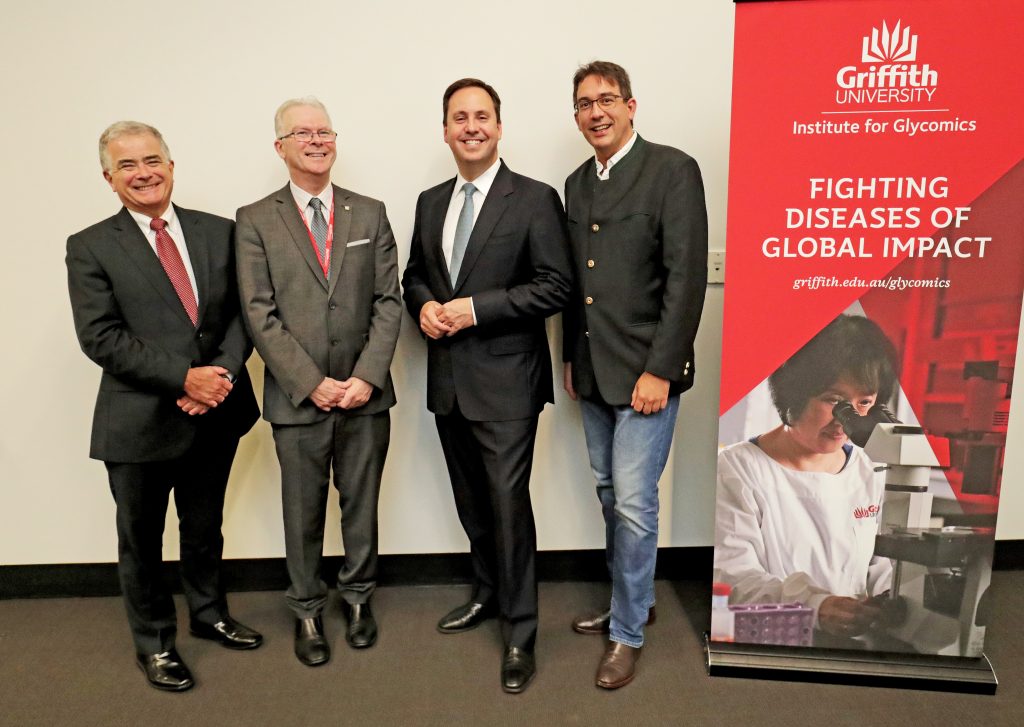A multi-million dollar investment by Griffith University to establish a world leading cancer research centre is now challenging traditional approaches to cancer testing and treatments.
The Institute for Glycomics at the University’s Gold Coast campus is now home to the newly-established Australian Centre for Cancer Glycomics.
Griffith University Vice Chancellor and President Professor Ian O’Connor said more than 7 million dollars has been invested in the new centre, the only one of its kind in Australia.
“Our researchers are pushing the boundaries in biomedical research and working towards the discovery of new cancer diagnostics, drugs and vaccines which will have global impact,” Professor O’Connor said.
Local Federal Member and Minister for Trade, Tourism and Investment the Honourable Steven Ciobo MP has toured the Institute and appreciates the wide-ranging impacts the centre has to offer.
Minister Ciobo said the Gold Coast is now attracting the world’s premier biomedical scientists in this highly specialised field
“This Centre is undertaking unique cancer research with the potential to unlock the mysteries of this insidious disease.”
Glycomics is the study of the carbohydrates that appear on the surface of both healthy and diseased cells. Human cells are covered with a thick layer of carbohydrate chains known as glycans that provide unique cell sugar signatures and form the cell’s sugar coat.
These so-called signatures play a pivotal role in the life of a cell not the least being their part in determining cancer growth and development.
Director for the Institute for Glycomics Professor Mark von Itzstein said their work is singular as it has an entire focus on the impact and changes which are made to the sugar signatures on the surface of cancer cells.
“As the human genome has detected gene-related changes in certain cancer cells, it’s these sugar signatures that will allow us to not only detect but also lead us to developing new treatments and vaccines.”
Professor von Itzstein, one of the pioneers of the world’s first-ever anti-influenza drug Relenza, believes glycomics gives researchers the opportunity for new diagnostics for early intervention and for both drug and vaccine discovery.
Crucial to its work, the Centre is partnering with a range of other national and international institutions including the Chris O’Brien Lifehouse which is providing access to vital patient data and thousands of stored cancer tissue samples.
The Lifehouse Centre has been working closely with Griffith’s researchers and brings together one of the nation’s largest academic cancer centres treating thousands of patients annually.
“It’s all about gathering as much clinical data as we can as a rich knowledge base will help analyse, understand and subsequently treat poorly addressed cancers,” Professor von Itzstein said.
(l-R Vice Chancellor Ian O’Connor, Professor Mark von Itzstein, Honourable Steven Ciobo MP, Assoc. Prof. Daniel Kolarich)
The newly formed Centre has also initiated a major collaboration with Distinguished Professor Judith Clements AC, Scientific Director of the Australian Prostate Cancer Research Centre and also engaged local surgeons in establishing a dedicated Melanoma Cell Bank.
Oncology surgeon Dr Nic Crampton has been working alongside the Institute for Glycomics for a number of years and is delighted the Centre is now being launched on the Gold Coast.
“To have both the new research centre and the cell bank close by means we can readily identify, analyse and target the best ways of treating and fighting melanoma”, he said.
Part of the Gold Coast’s Health and Knowledge precinct, the Institute for Glycomics has successfully developed a host of drug and vaccine discovery programs, particularly cancer and infectious diseases since opening in 2000.
Programs have already yielded major discoveries for metastatic cancers such as melanoma and blood cancers like childhood leukaemia and non-Hodgkin’s lymphoma.

